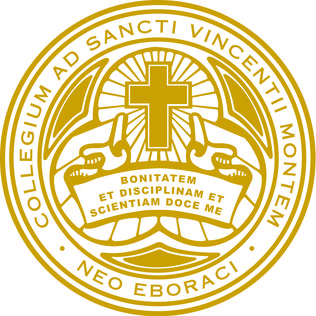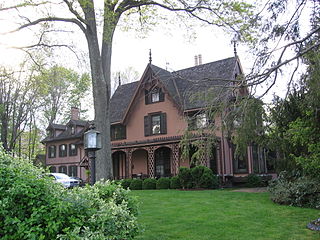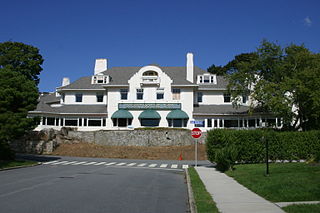
Eugene Gladstone O'Neill was an American playwright and Nobel laureate in literature. His poetically titled plays were among the first to introduce into the U.S. the drama techniques of realism earlier associated with Russian playwright Anton Chekhov, Norwegian playwright Henrik Ibsen, and Swedish playwright August Strindberg. The tragedy Long Day's Journey into Night is often numbered on the short list of the finest U.S. plays in the 20th century, alongside Tennessee Williams's A Streetcar Named Desire and Arthur Miller's Death of a Salesman.

New London is a seaport city and a port of entry on the northeast coast of the United States, located at the mouth of the Thames River in New London County, Connecticut. It was one of the world's three busiest whaling ports for several decades beginning in the early 19th century, along with Nantucket and New Bedford, Massachusetts. The wealth that whaling brought into the city furnished the capital to fund much of the city's present architecture. The city subsequently became home to other shipping and manufacturing industries, but it has gradually lost most of its industrial heart.

Long Day's Journey into Night is a play in four acts written by American playwright Eugene O'Neill in 1939–41, first published posthumously in 1956. The play is widely considered to be his magnum opus and one of the finest American plays of the 20th century. It premiered in Sweden in February 1956 and then opened on Broadway in November 1956, winning the Tony Award for Best Play.

The Chautauqua Institution is a 501(c)(3) nonprofit education center and summer resort for adults and youth located on 2,070 acres (8.4 km2) in Chautauqua, New York, 17 miles (27 km) northwest of Jamestown in the southwestern part of New York State. Established in 1874, the institution was the home of and provided the impetus for the Chautauqua movement that became popular in the US in the late 19th and early 20th centuries. The Chautauqua Institution Historic District is listed on the National Register of Historic Places and was further designated a National Historic Landmark.

Cleveland Park is a residential neighborhood in the Northwest quadrant of Washington, D.C. It is located at 38°56′11″N77°3′58″W and bounded approximately by Rock Creek Park to the east, Wisconsin and Idaho Avenues to the west, Klingle and Woodley Roads to the south, and Rodman and Tilden Streets to the north. Its main commercial corridor lies along Connecticut Avenue NW, where the eponymous Cleveland Park station of the Washington Metro's Red Line can be found; another commercial corridor lies along Wisconsin Avenue. The neighborhood is known for its many late 19th century homes and the historic Art Deco Uptown Theater. It is also home to the William L. Slayton House and the Park and Shop, built in 1930 and one of the earliest strip malls.
Monte Cristo or Montecristo may refer to:

James O'Neill was an Irish-American theatre actor and the father of the American playwright Eugene O'Neill.

The Eugene O'Neill National Historic Site, located in Danville, California, preserves Tao House, the Monterey Colonial hillside home of America's only Nobel Prize-winning playwright, Eugene O'Neill.

The College of Mount Saint Vincent (CMSV) is a Catholic liberal arts college in New York City. It was founded in 1847 by the Sisters of Charity of New York.

Hamilton Grange National Memorial, also known as The Grange or the Hamilton Grange Mansion, is a National Park Service site in St. Nicholas Park, Manhattan, New York City, that preserves the relocated home of U.S. Founding Father Alexander Hamilton. The mansion holds a restoration of the interior rooms and an interactive exhibit on the newly constructed ground floor for visitors. The Hamilton Heights subsection of Harlem derived its name from Hamilton's 32-acre estate there.

The Morris–Butler House is a Second Empire-style house built about 1864 in the Old Northside Historic District of Indianapolis, Indiana. Restored as a museum home by Indiana Landmarks between 1964 and 1969, the American Civil War-era residence was the non-profit organization's first preservation project. Restoration work retained some of its original architectural features, and the home was furnished in Victorian and Post-Victorian styles. Its use was changed to a venue for Indiana Landmarks programs, special events, and private rentals following a refurbishment in 2013. Regular daily tours of the property have been discontinued.

The Isaac Bell House is a historic house and National Historic Landmark at 70 Perry Street in Newport, Rhode Island. Also known as Edna Villa, it is one of the outstanding examples of Shingle Style architecture in the United States. It was designed by McKim, Mead, and White, and built during the Gilded Age, when Newport was the summer resort of choice for some of America's wealthiest families.

Roseland Cottage, also known as Henry C. Bowen House or as Bowen Cottage, is a historic house located on Route 169 in Woodstock, Connecticut, United States. The house was added to the National Register of Historic Places in 1977, and was declared a National Historic Landmark in 1992. It is described as one of the best-preserved and best-documented Gothic summer houses in the nation, with virtually intact interior decorations.

Hill–Stead Museum is a Colonial Revival house and art museum set on a large estate at 35 Mountain Road in Farmington, Connecticut. It is best known for its French Impressionist masterpieces, architecture, and stately grounds. The property was designated a National Historic Landmark as a nationally significant example of Colonial Revival architecture, built in 1901 to designs that were the result of a unique collaboration between Theodate Pope Riddle, one of the United States' first female architects, and the renowned firm of McKim, Mead & White. The house was built for Riddle's father, Alfred Atmore Pope, and the art collection it houses was collected by Pope and Riddle.

The Eugene O'Neill Theater Center in Waterford, Connecticut, is a 501(c)(3) non-profit theater company founded in 1964 by George C. White. It is commonly referred to as The O'Neill. The center has received two Tony Awards, the 1979 Special Award and the 2010 Regional Theatre Award. President Obama presented the 2015 National Medal of Arts to The O'Neill on September 22, 2016.

The Lewis Miller Cottage is a historic house at Whitfield and Vincent Avenues, on the grounds of the Chautauqua Institute in Chautauqua, New York. Built in 1874, it was the residence of Lewis Miller, founder and leader of the Chautauqua movement. It was named a National Historic Landmark in 1965 for its association with Miller, and is included in the larger Chautauqua Institution Historic District, also a National Historic Landmark.

The Jonathan Sturges House is a historic house at 449 Mill Plain Road in Fairfield, Connecticut. Built in 1840 to a design by Joseph Collins Wells, it is one of the oldest-known and best-documented examples of architect-designed Gothic Revival architecture. The house was declared a National Historic Landmark in 1994 for its architectural significance. It was designed and built for Jonathan Sturges (1802–74), a New York City businessman and patron of the arts, in whose family the property remains.

The Stephen Tyng Mather Home is a historic house and National Historic Landmark at 19 Stephen Mather Road in Darien, Connecticut. It is significant as the longtime family home Stephen Tyng Mather (1867–1930), an industrialist and conservationist who championed the creation of the National Park Service in 1916 and served as its first director. The main house was built in 1778 by his great grandfather, Deacon Mather. Stephen Mather often lived elsewhere, but regarded this house as his true home.

The Ernest Hemingway Cottage, also known as Windemere, was the boyhood summer home of author Ernest Hemingway, on Walloon Lake in Michigan. It was declared a National Historic Landmark in 1968.

The Lighthouse Inn, originally known as Meadow Court, is a Colonial Revival hotel building at 6 Guthrie Place in New London, Connecticut. The Mission style main house was designed by William Ralph Emerson and built in 1902 as a country home for steel industry magnate Charles S. Guthrie. It is one of the few examples of this architectural style in the city, and became a popular dining and event venue after opening as an inn in 1927. The building and surviving estate remnants were listed on the National Register of Historic Places in 1996. It was listed for sale by the city in February 2014, with historic preservation restrictions.























